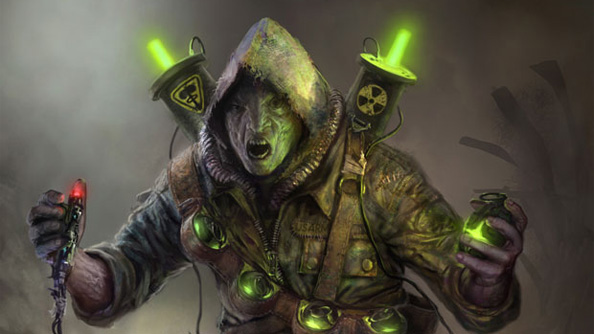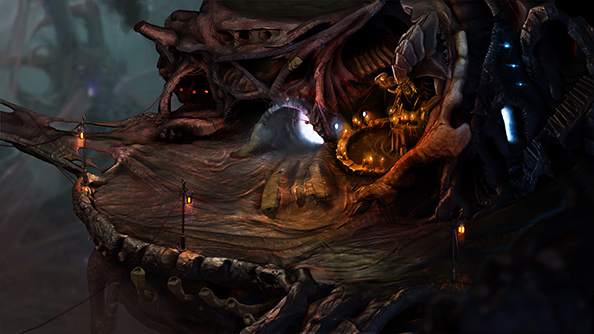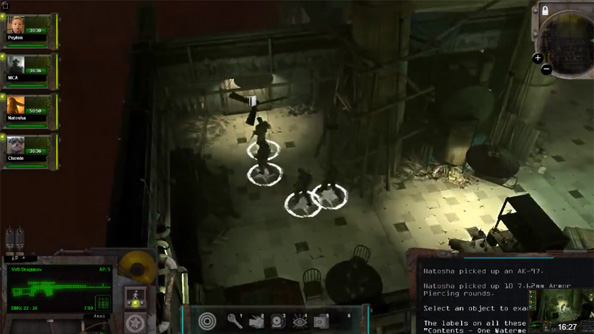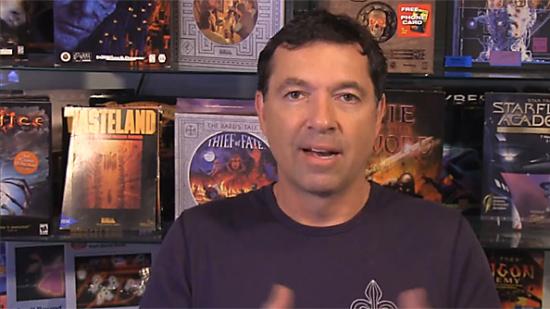The Torment: Tides of Numenera crowdfunding effort came to a juddering, money-soaked end three days ago, raising over $4 million dollars for inXile and breaking the record for most money ever raised on a videogame Kickstarter. Not only does that prove beyond all doubt that people really, really would like to play a single-player isometric RPG quasi-sequel to Planescape: Torment, it also shows that inXile’s Brian Fargo has something of a knack for Kickstarting his projects. His last campaign to revive the decades old Wasteland series was met with similarly sized piles of backers’ cash — the man’s got the Midas touch when it comes to lightening the wallets of PC gamers.
I spoke to the inXile founder during GDC, around breakfast time. The Torment campaign had blasted through its $900,000 target and was accelerating towards its four millionth dollar, hitting stretch goal after effortless stretch goal. He was eating some toast.
PCGamesN: So, to state the obvious, you must be fairly pleased with how the Kickstarter’s gone.
Brian Fargo: Pleased is an understatement. I feel so fortunate to be in this great position where the fans have trusted us, it’s the complete opposite to when you’re a developer working for a publisher, it’s a very different atmosphere. But when you’re crowdfunding, they’re giving you the money up front and saying “we trust you to do it”. I take my responsibilities super seriously, so we’re not going to fail these people, but I think we’re so fortunate to be in this position to do it.
PCGN: It’s interesting that the first actual screenshot of Torment has only just arrived now, at the very end of the campaign. Why was that?
BF: I think primarily, when we do a Kickstarter, we put down a number that we need to be able to deliver a product against, we need to assume that we can make a game for the minumum that comes in. So in order to do this sort of pre-rendered style — people like to call it 2D versus 3D, I like to call it pre-renderered versus rendered on the fly — it requires artists to go in by hand and to touch up these screens and to do paint overs, so it’s a different kind of more expensive process.
I didn’t know for sure if we were going to achieve these kinds of numbers. Of course we hoped we would, so we went blasting through concept art pretty quickly, but this style isn’t something you do quickly. We had a lot of assets we had to work on to launch Kickstarter, those concept pieces and so forth, so this style didn’t quite get number one priority because we weren’t certain if we were going to be able to do it. Now we’ve been working on it for the last three weeks and here’s what you got. That’s why the screen came later in the campaign, but we were okay with that knowing it was a possibility. I mean, we looked at Project Eternity, they didn’t show their screenshots until later in the campaign either so it seemed an okay thing to do if we didn’t have it right up front. Especially as we didn’t want to show it up front and not be able to deliver on it.
PCGN: Is it a challenge to sell a Kickstarter campaign on concept art alone? What’s the worth of that artwork to you, as a developer?
BF: I like to start with the concept because there are no technical parameters, let’s just dial in the look that we have that really captures the feel of what we want to do. Then when we’ve done that we’ve set the bar really high and we can say, how do we get to that? And that drives us to push ourselves harder, and that’s how I’ve always done it. That’s why they can be meaningful when done properly.
PCGN: When you reboot these old IPs, fans often have diametrically opposed ideas about what they want the game to be. Is it a problem making sure most of your backers are satisified?
BF: Ahh, no problem at all. None! Well yeah, I mean, it’s sort of a yes and a no. You’re right, not only are you trying to build a product, you’re trying to build a product that’s often based upon their memory of what it was, and not even what it actually was. We all get fonder of things as time passes, so I recognise that we are competing with people’s memories of those games also. Not what they actually were.
The reason I have confidence is because our communication is much tighter than it’s ever been before. Back in the days when we worked on Wasteland or Fallout of Planescape: Torment, we would work on these games in a vaccum and then hope we nailed it. We’d realease it and keep our fingers crossed. Kickstarter is anything but that, we’re in this constant communication, showing them things and reacting and modifying and dialling it in. We have our own sensibilities too, we know what pillars we’re going to hit and those aren’t going to change, but they know what those are and we know what those are. It allows us a greater confidence that we’re delivering against a vision.
The other part of it is that we have an amazing writing staff on this team. It’s unbelievable, you know, we’ve got Colin McComb, Pat Rothfuss, Chris Avellone. It’s an amazing team of writers, so if anybody can do it it’s these guys.
PCGN: Chris Avellone is a sort of strange, human stretch goal for this campaign. What happens if you don’t hit the target to hire him? Does he just go away?[At the time of the interview, the $3.5 million stretch goal target to hire Avellone had not yet been reached]
BF: Well look, if we come up a dollar short am I not gonna do it? Of course not. We have to put the stretch goals down. There is an increased cost of bringing him aboard though, we have to take his time from Obsidian, that costs a lot, and then we have to create whatever it is that he builds. It’s fine that it comes from his mind, but now we’ve got to possibly do more work and art and so on, so it’s not just pure writing. But yeah, if obviously we’re right there, we’re not going to get ridiculous about it.

PCGN: I’m interested to learn how you arrived at the target you set for both of your Kickstarters. Why $900,000?
BF: Basically, we start off thinking, how can we create an experience that captures what we’re trying to do for the minimum amount of money. And it’s a combination of what we raise from Kickstarter, and you know, I’ve always been willing to pitch in a couple of extra dollars myself, and we also have some recurring revenue from our back catalogue that comes in. So we look at those three factors and decide what we can do. In reality it’s a little bit more than this $900,000, but it’s within that ballpark. We just sort of scope out a game that’s within that range. We hope that it goes higher but we can’t plan on it.
PCGN: Is it partly psychological, does keeping the goal below $1 million make it appear more achievable, and so attract more backers?
BF: Well let’s go back to Wasteland for a second. Double Fine had only asked for $400,000 and they were doing great, and so when I was getting ready for Wasteland people said: don’t you dare ask for more than $400,000, you’ll look greedy. I knew there was no way I could make the game for $400,000. I couldn’t do it, so we had to ask for more money. I figured it was about at least a million, so there was some psychology behind that. Like hey, you guys put up nine hundred thousand, I’ll put up the other hundred, I’m in this too. So it was more like a million dollar budget.
That’s how we came up with the first number. For the Torment campaign the landscape had changed and some other Kickstarters had come along. Elite had asked for something like £1 million and some odd pounds [£1,250,000], and ended raising about $2 million [£1,578,316]. But I felt like we should just match what we did the first time because it felt right, and we could avoid questions like, why did this one cost more than the last?
It just seemed like staying consistent with that one made sense. I think the ground rules change constantly for what’s okay and what’s not okay. We try to recogise the factors and either adjust the scope and scale but also keep in mind what we really can do. That gives you a minimum, maximum bar.
PCGN: About those ground rules. The internet seems to have an instinct when it comes to who it perceives as ‘deserving’ of Kickstarter money, and whether the developer should be able to self-fund rather than seek backing from fans. As a successful developer, did you encounter this sort of feeling?
BF: Maybe a little bit. You’re right, there’s absolutely an understanding you need of who everybody is. To me, understanding them goes beyond crowdfunding, it also goes into what the product is. I think your ability to gauge and understand the people that want to play these games is critical, even from a production perspective. But I went out and pitched these products to publishers, I did it for ten years, there were no takers, so that one’s off the table.
Just look at Wasteland and Torment, we’re bringing these two games back, and between the two we’ve raised about $6 million. There is not a venture capitalist alive who would’ve given us $6 million to go make two old school PC turn-based role-playing games. It would’ve never happened. So I think that people are pretty aware of that. You do get certain dynamics that kick in when [backers] think that there are other opportunities, but for us there really wasn’t another option to get these things made.

PCGN: Hypothetically speaking, if you could turn back time and somehow show a publisher that Wasteland and Torment have an audience, would things have panned out differently?
BF: Hmmm, it’s hard to say. You have to remember that, I’m going to make up some numbers here, but we’ve got 60,000 people who’ve backed the projects. Let’s say I go out digitally and, we could do better, but let’s say I sell another 100,000. So that’s 160,000 pieces to a publisher? That’s a waste of their time. Activision could probably sit down in an afternoon and figure out how to sell 160,000 more copies of Call of Duty in some region and have it done in a week, done and dusted. So the numbers they’re looking for means that our numbers just aren’t very exciting for them.
For us though, it couldn’t be better. Our success is their failure, in terms of numbers. Gosh, if we deliver on these games, and we will deliver on these games, and we just do these kinds of units, nothing crazy happens and it allows me and my guys to make roleplaying games for another decade. And that’s fantastic, and all within numbers that just aren’t exciting to publishers.
PCGN: Could you ever go back to traditional publishing, or is Kickstarter the way forward for inXile?
BF:I’d like to be able to continue to control my destiny, I’m used to doing that. I’m not used to working for publisher and being at their whim, so I’m very comfortable doing this and delivering a finished product. If the landscape were to change and there was no Kickstarter, I’d still continue along this route of self-financing or raising money or whatever to continue doing what we’re doing.
PCGN: Are there any pitfalls of launching a Kickstarter that you’ve seen other campaigns run into? Any hot Kickstarter tips?
BF: You really have to think through your tier levels to ensure that they all work together and are fair. We worked with our users before we launched to make sure we don’t do something that rubs people to wrong way. That’s very critical. Timing of when you launch is important, if there’s something else in the same category as your game when you launch you’ve got to be careful. Especially if they’re big. I’ve seen some bad timing out there.
One of the most difficult parts of launching a Kickstarter is getting the press to care. For you guys I’m sure it’s like nails on a chalkboard hearing about new Kickstarters every week. You know, we shattered the Kickstarter record, we had the record for like six days until Veronica Mars came along. We mentioned that to a couple of outlets, like hey, this might be an interesting story. And they were like, ehhh, we’ve covered your Kickstarter already. That’s so typical of our industry and how fast it moves, you’ve got a world record and it’s taken in six days.
PCGN: I had no idea who Veronica Mars was until Twitter exploded. I still don’t.
BF: Listen, neither did I, when my guys told me we were about to lose our record to Veronica Mars, I said “who’s that?”
PCGN: Putting Torment to one side, what stage are you at now in Wasteland’s development?
BF: We had a really important milestone in February when we took a snapshot of us playing the actual game. We didn’t create a demo for a trade show, we waited until it was organically ready and correct. We captured about 15 minutes of gameplay and backers could see some of the interface, they could read the text and get a sense of the style, the graphics, the combat systems the nuances, the use of skills and so on. People loved it, they absolutely loved it. In fact, I wouldn’t have launched the Torment Kickstarter if they didn’t love that, but they did.
So that was a good sign for us because from this point on I just need to do more of that. There are no more technological hurdles left, it’s just a matter of implementing all of the grand depth of design that we have. And so everything’s coming along very nicely. Our next internal milestone is that, by the end of April, all the levels will be in and playable in a rough blockout form, so we can have people come in and play the game and start iterating and iterating and iterating. As we march towards summer we’ll start sneaking out areas for people to play to prepare ourselves for a full beta test. It’s coming along very nicely.

PCGN: I’m looking at your Wasteland footage on YouTube now, and I’ve just been shown a pre-roll ad for diapers.
BF: Wow, yeah, they really targeted their audience well there.
PCGN: Well I guess I do suffer from incontinence.
BF: How did they know?
PCGN: Google track everything.
BF: Yeah, they’ve even got sensors in the toilets now.
PCGN: Thank you for your time, Brian.
